HOW TO HOLD THE GUITAR
- Introduction
- Guitar positioning for the left thigh.
- Why should the angle of the neck in relation to the floor be about 45-55°?
- Right hand placement on the guitar.
- Guitar positioning for the right thigh.
- Playing with the guitar strap.
- Сonclusions
Introduction
Many future guitarists very often miss the first yet not the last important step in learning – how to hold a guitar.
There are three main ways:
- Sitting on a chair, hold the guitar on your left thigh (Figure 1).
- Sitting on a chair, hold the guitar on your right thigh (Figure 2).
- Play standing or sitting with the guitar hanging from its strap (Figure 3).
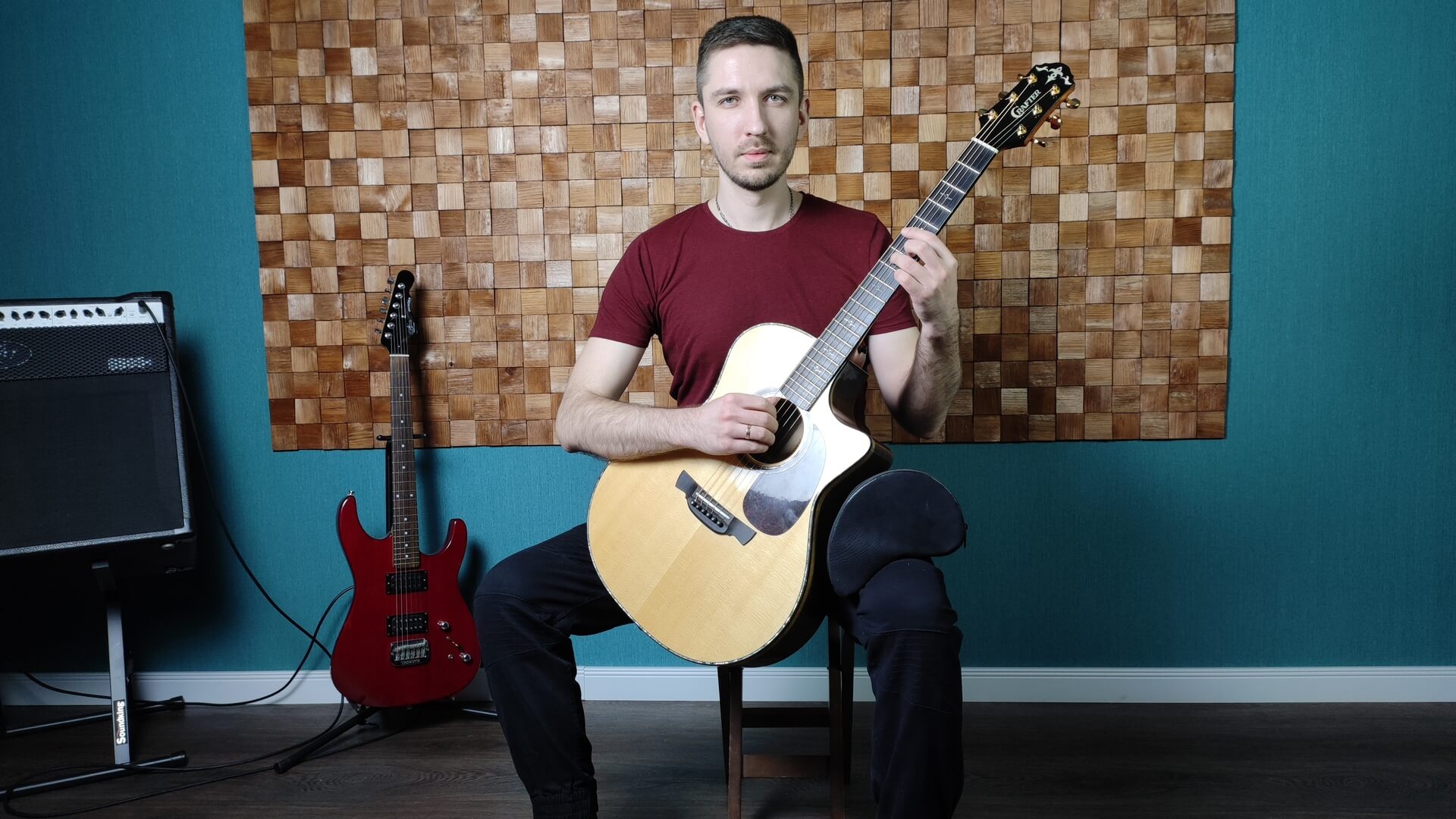

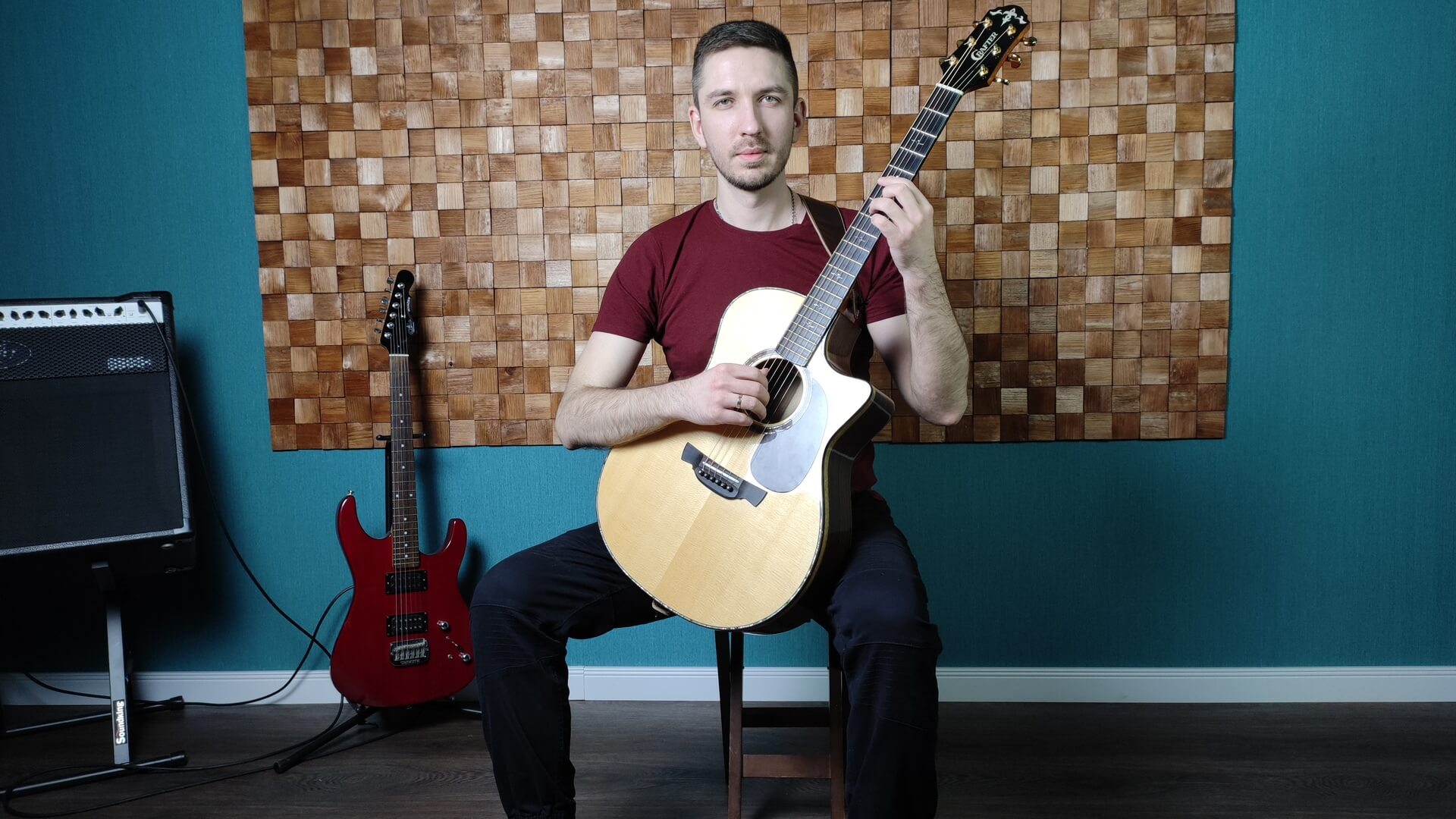
Each method has its own advantages and disadvantages, and there is no single ideal way. Therefore, it remains only for you to choose, weighing all the pros and cons.
To play your guitar comfortably, the seat you choose while playing must satisfy three basic requirements:
- Comfort and convenience. If you hold your guitar correctly, you will be able to play for a long time without fatigue, back pain, muscle pain, or swelling in your hands and feet. That is, you should just sit straight and relaxed, as you usually sit in a chair without a guitar.
- The stability of the position of the instrument. The guitar should be in a very stable state, not oscillate or come out of rest.
- Maximum mobility and freedom of movement of hands and fingers should be ensured. Nothing should restrict your movements. Both the right and left hand are often in different positions on the strings and often move along them. For example, when playing two-handed tapping, the right hand is placed in the same place as the left. Therefore, your hands should be able to move totally calmly, freely, and quickly.
First of all, before taking the guitar let’s find the height of the chair.
For each individual, a different chair height should be selected. How to find this height?
To play the guitar comfortably, you need a chair height where your thigh is parallel to the floor (Figure 4). As you can see my chair is a bit high 🙂 If the chair is very low, your legs will be bent at the knees too much, which will cause to numbness in the legs. If it is very high, the guitar will continually slide down the thigh.
Next, you will sit on the edge of your chair. The purpose is so your guitar doesn’t touch the chair.
A few things to keep in mind:
- Make sure your back is straight.
- Your legs don’t bend under the chair
- And do not straighten your legs forward.
Lower your arms down so they hang freely. Feel the ease and relaxation of this position. When you take the guitar, you should keep that position and the feeling of comfort as much as possible. You should not feel any tension in any part of the body, even in its slightest manifestation.
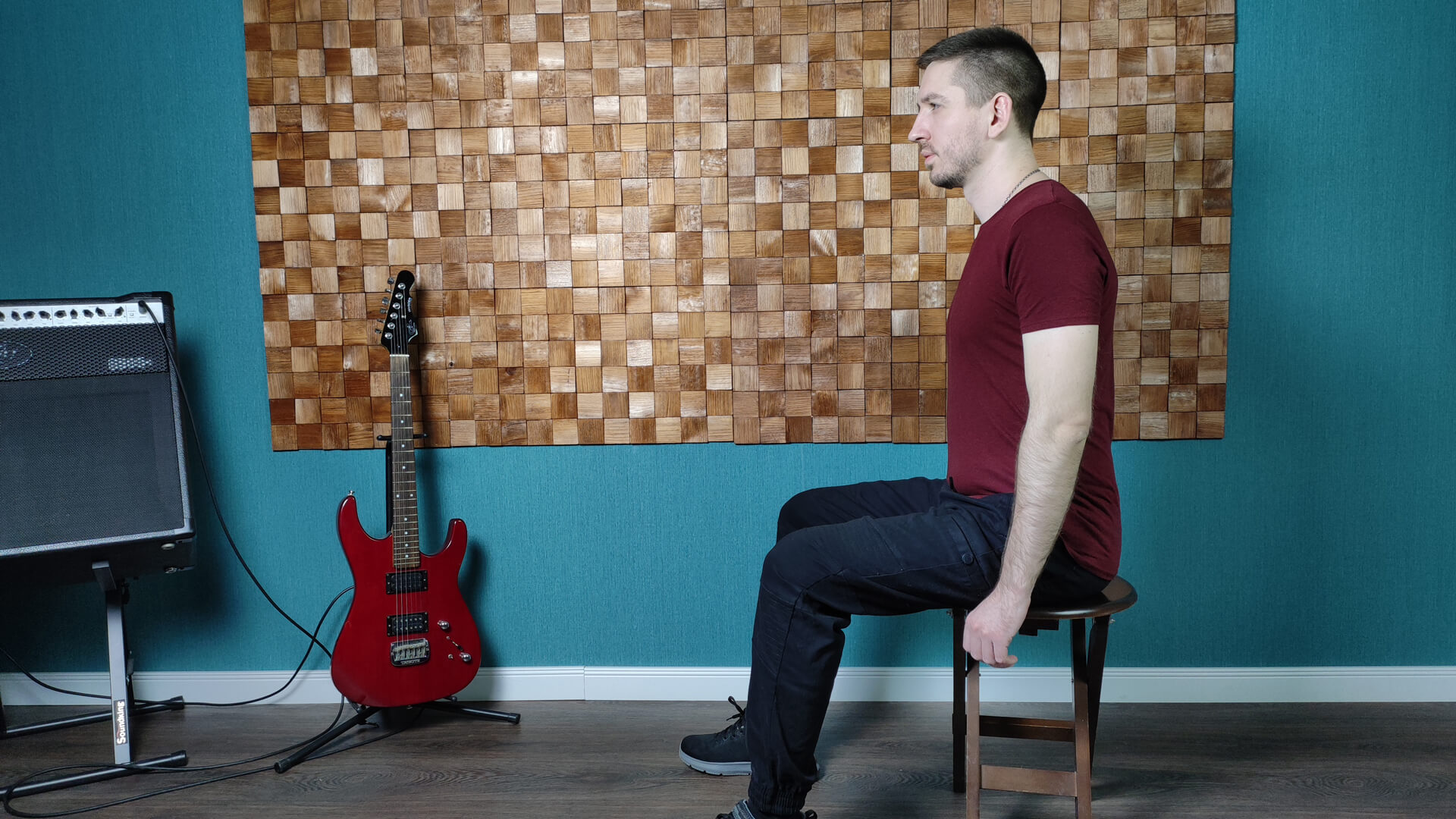
Guitar positioning for the left thigh.
First what we need is to choose one of the following:
- guitar footrest (Figure 5)
- guitar leg pad (Figure 6)
- special support that is attached to the side of the guitar (Figure 7)

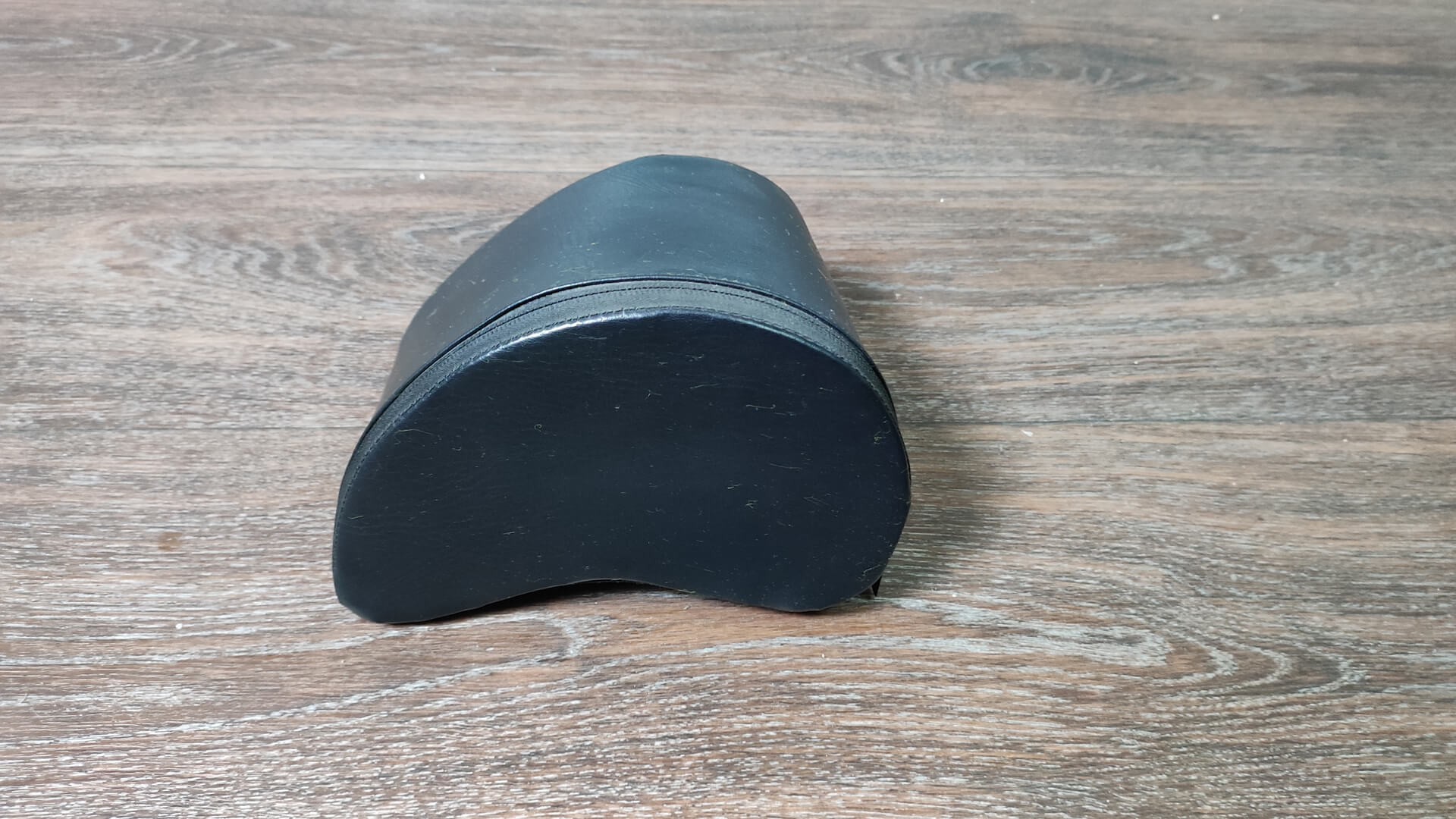
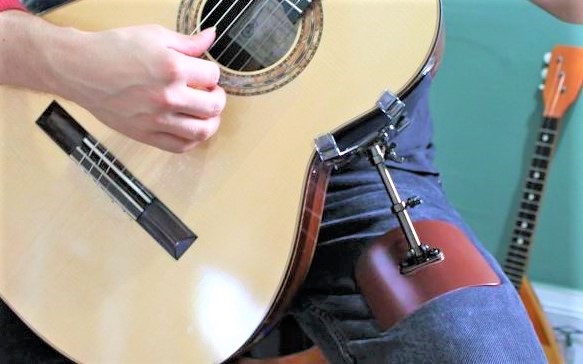
They are necessary because the goal is for the guitar to be positioned on the left thigh at about a 45-55 angle from the floor (Figure 8). A footrest is not recommended because they generally stand too high (Figure 9). This will lead to numbness in the leg, tightness in the thigh, and pain in the shoulder blades and back in general.
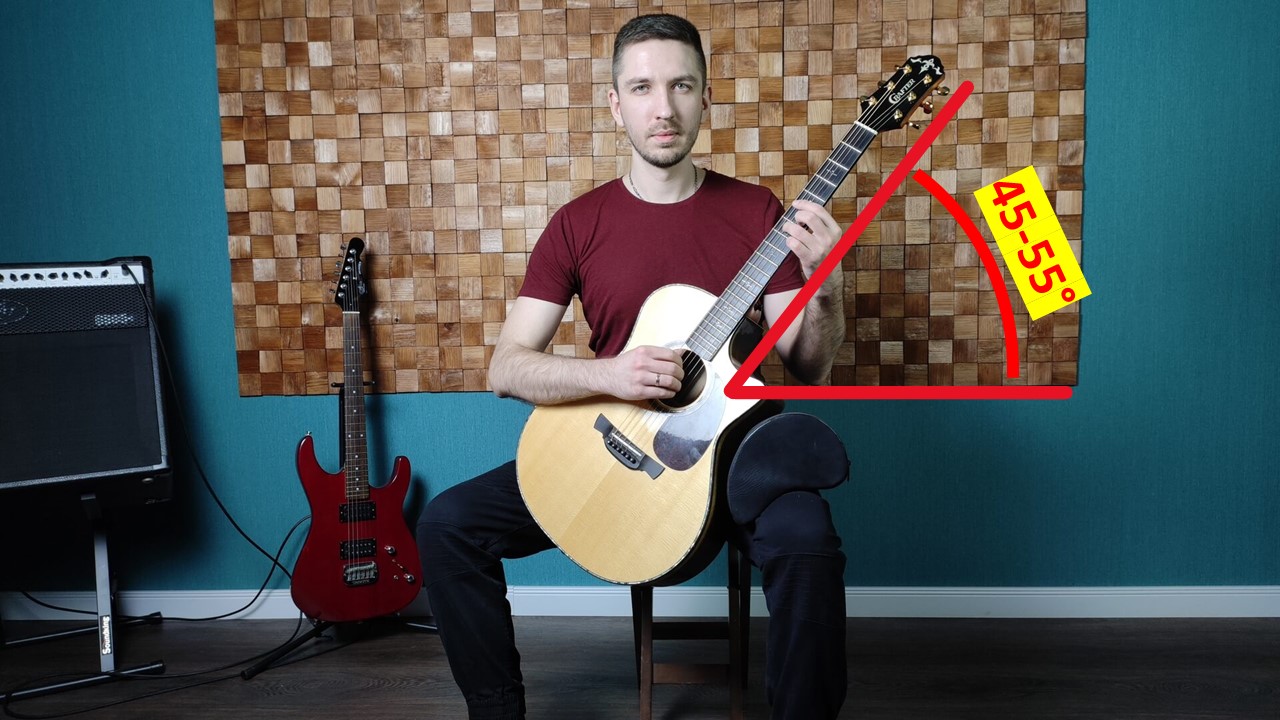
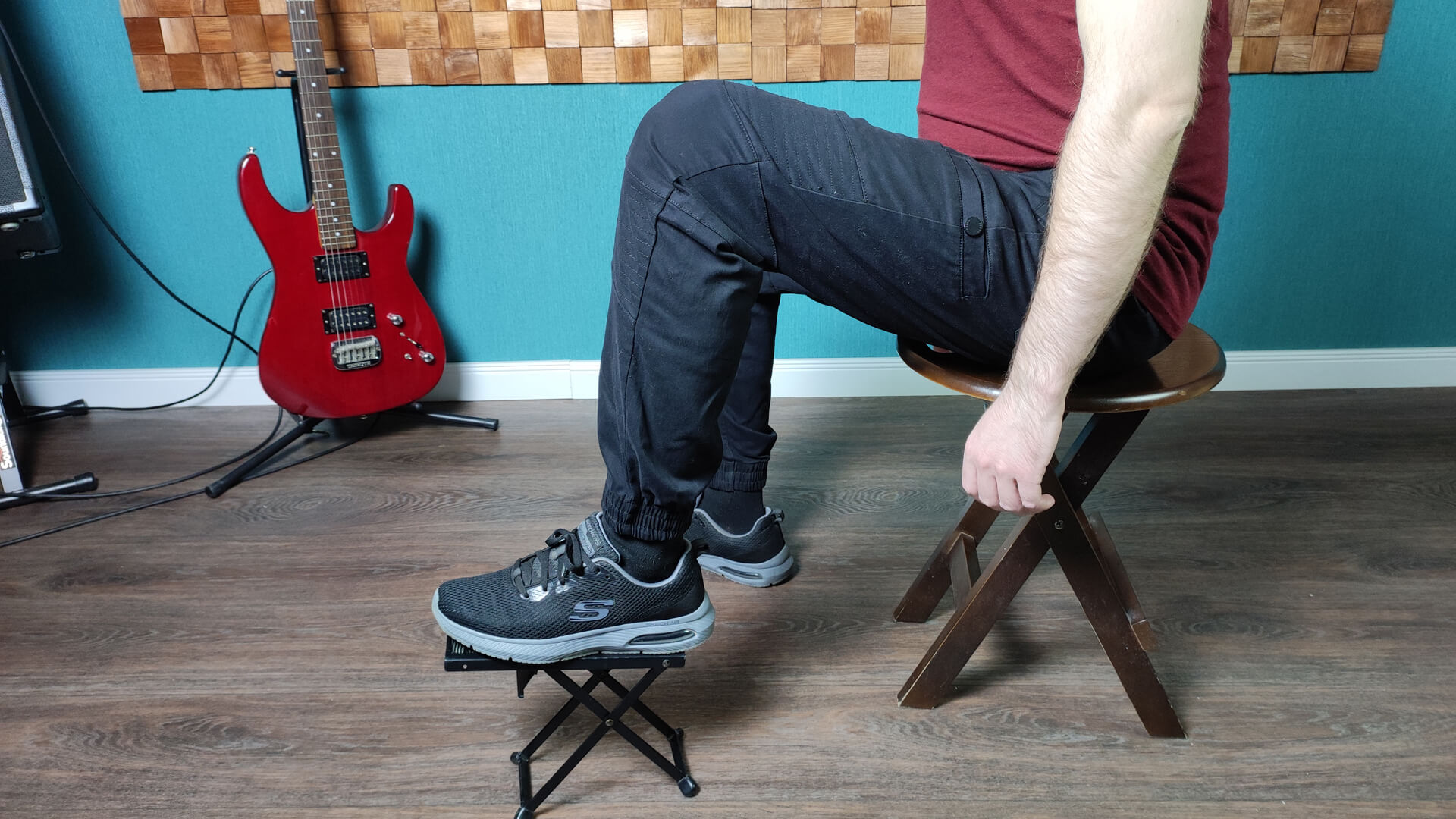
Place the cushion approximately in the center of your left thigh and the guitar on the cushion ‘to conform to’ the special curve of the side of the guitar (Figure 10). Or, if you must use a footrest, place your left foot on it and the guitar approximately in the center of your left thigh (Figure 11).
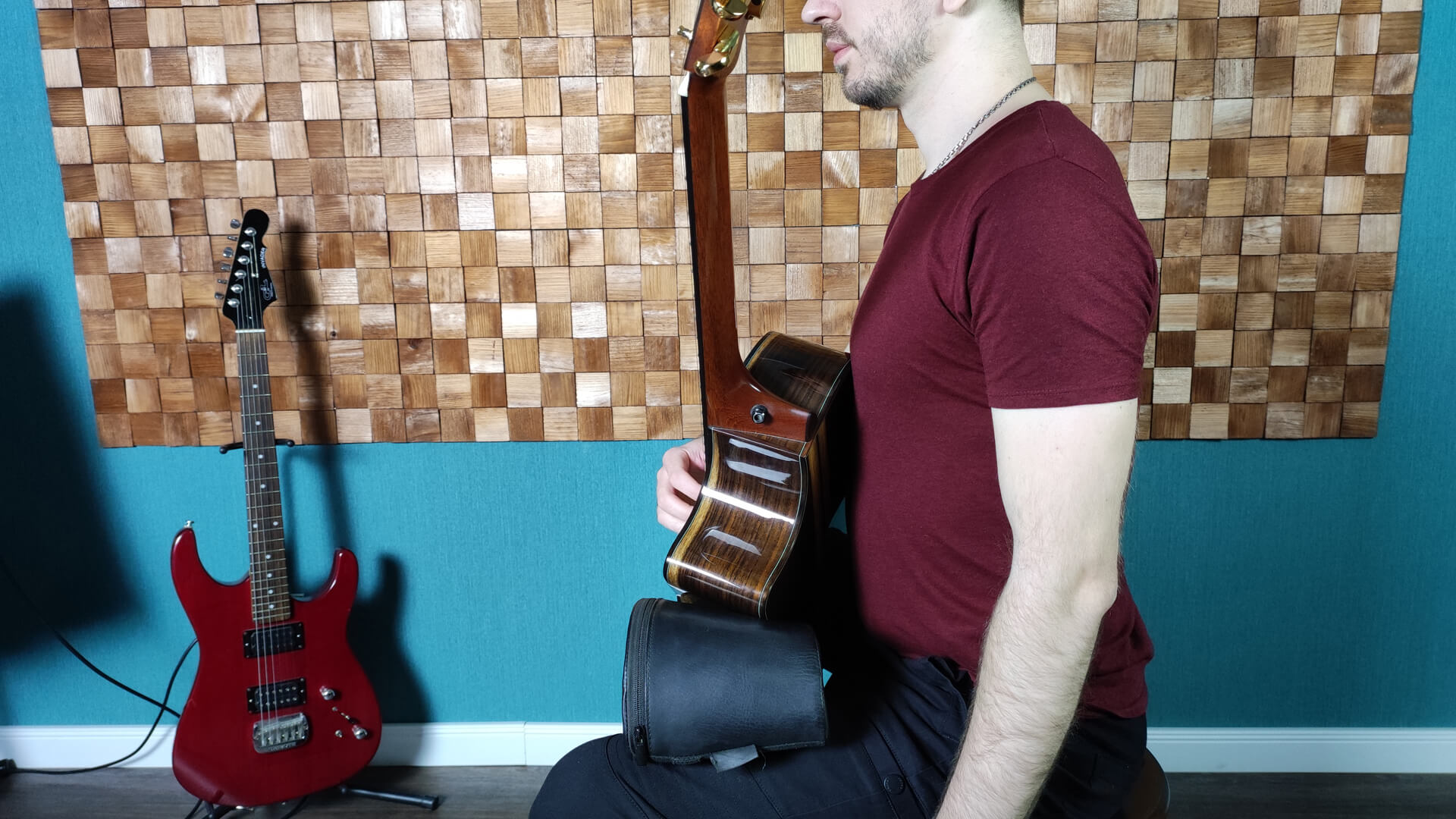
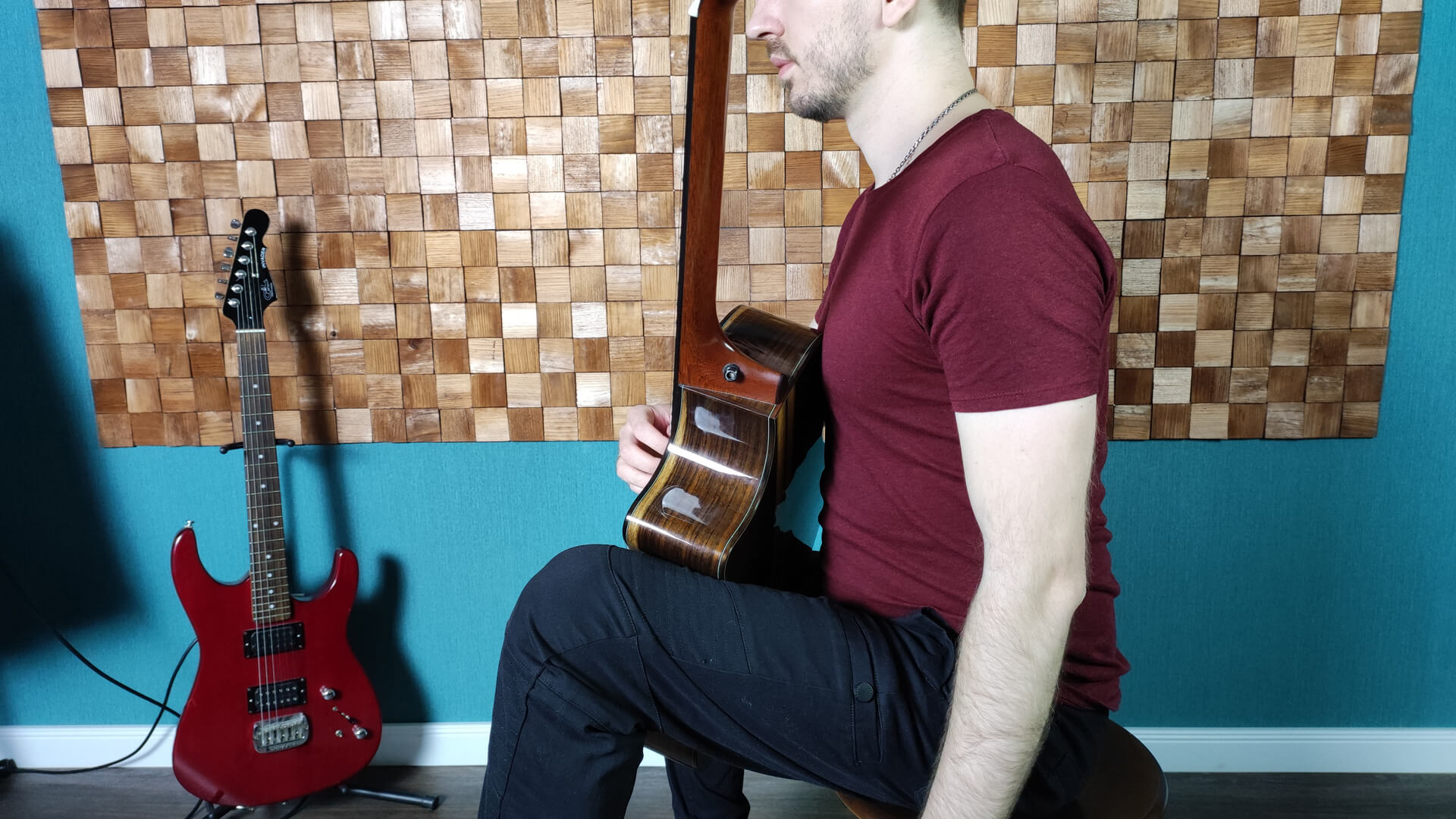
Tilt the guitar towards you so that it touches your chest. If you look from the side, you can see that the space between the back of the guitar and the player’s body resembles a triangle (Figure 12). If the guitar is closer to the knee and not in the middle of the thigh, it will almost lie down and constantly slide down the thigh. It will cause your wrist to bend at an unnatural angle and can cause pain from strain (Figure 13). If the guitar is closer to your body, you cannot see the strings and the elbow of your left hand will be pushed back a lot (Figure 14).
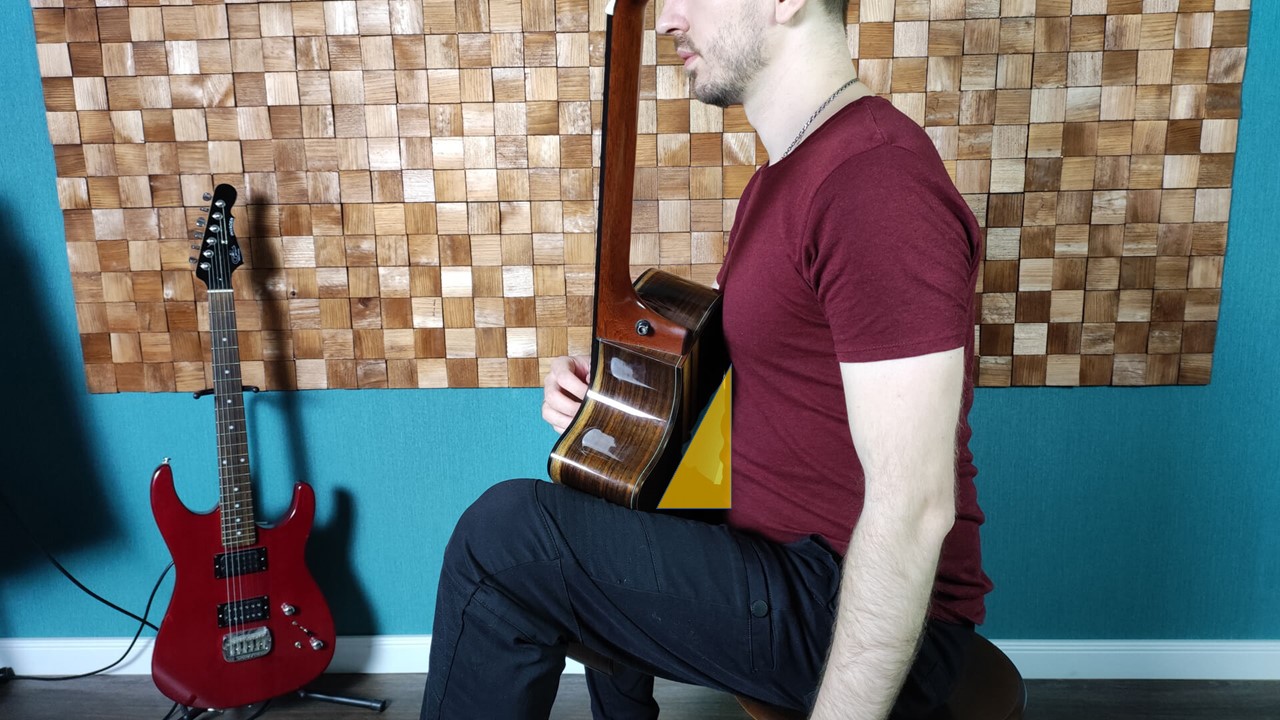
Optimal positioning is when the guitar is in the center of the thigh and you can slightly see the first string, without needing to bend over the guitar to see. The guitar itself is at an angle of about 20-30° in relation to our body (Figure 10,11,12,15).
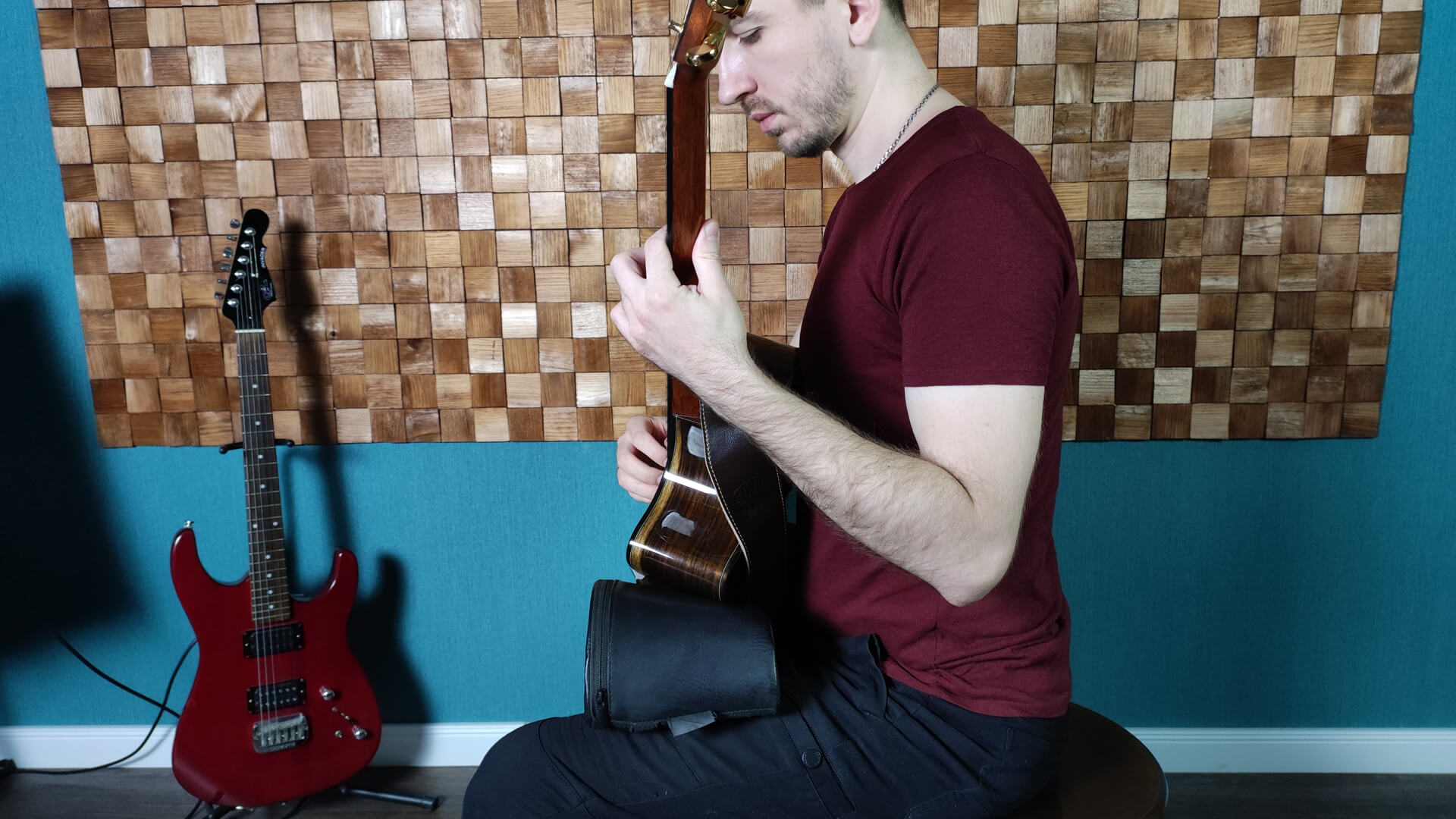
The neck of the guitar should be at an angle of approximately 45-55° to the floor (Figure 8). That is, the head of the neck is opposite your head. This is achieved by rotating the guitar over the thigh or cushion. The bottom part of the guitar is located between the legs and rests against the inner thigh of the right leg.
Why should the angle of the neck in relation to the floor be about 45-55°?
Let’s look at the relaxed hanging left hand. It hangs naturally like in the Figure 16, 17. Therefore, this is the most comfortable position for its natural playing, which must be maintained.

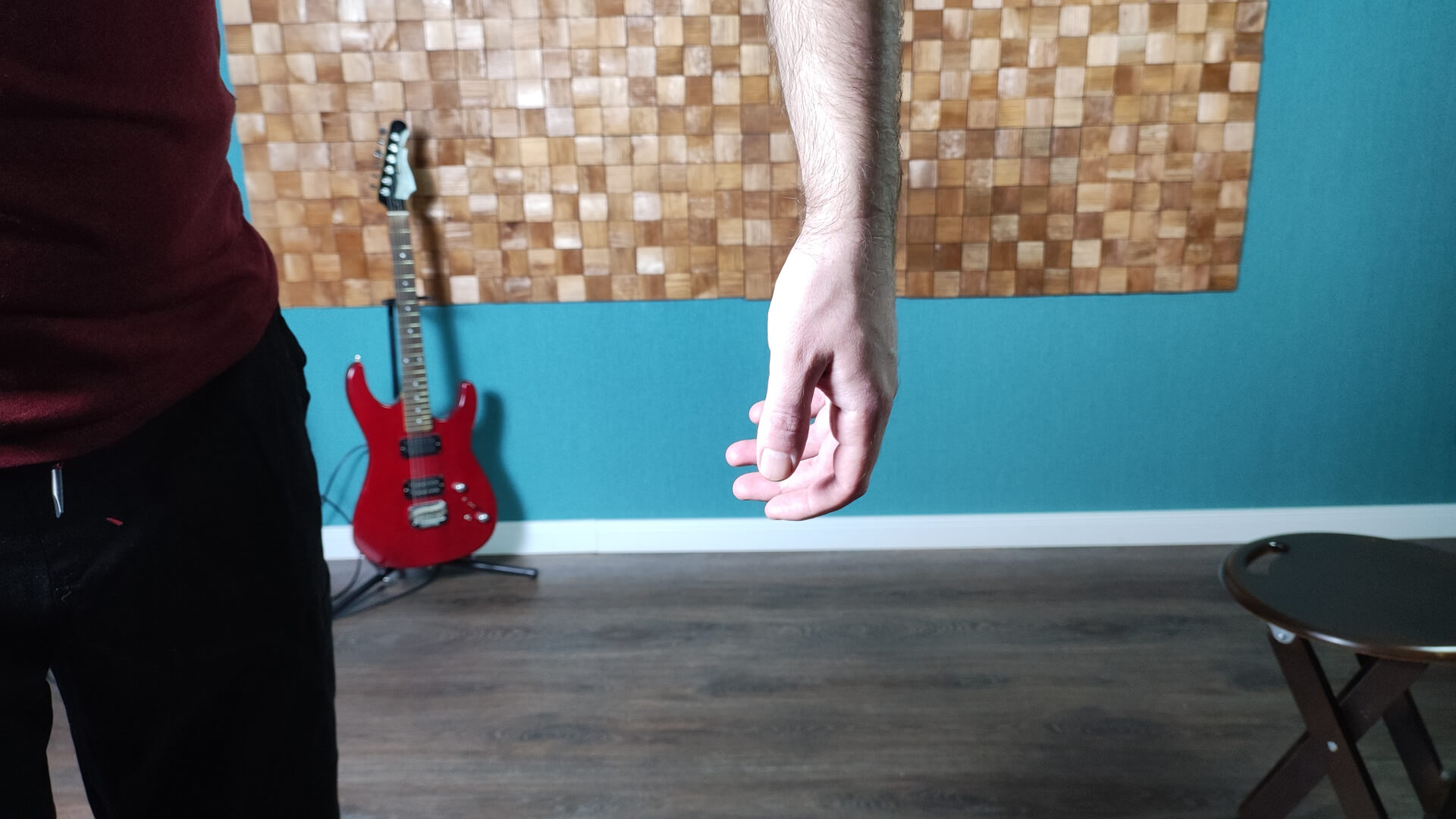
Now we raise our hand up, making sure that the elbow remains in place, not moving forward or backward, and the hand is in line with the forearm (Figure 18). Rotate your palm so that it is parallel to the neck.

Place your thumb on the back of the neck, slightly above the center of it (Figure 19, 20). Try to touch the neck lightly, without excessive pressure. The fingers are completely relaxed. As long as we don’t put them anywhere. They just hang lightly over the strings. For now, your fingers should hang relaxed over the strings in a semicircle shape (Figure 21, 22).
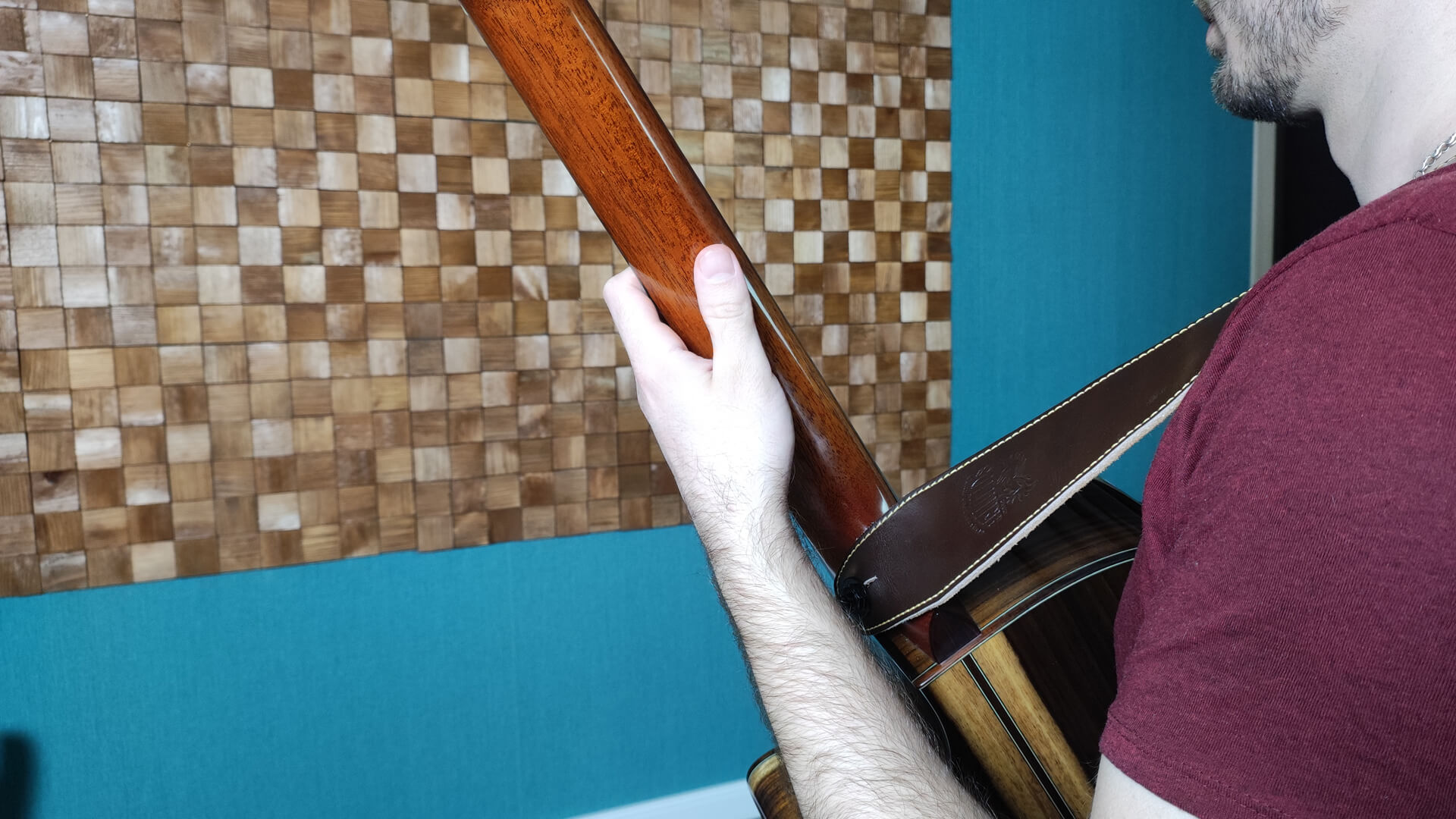
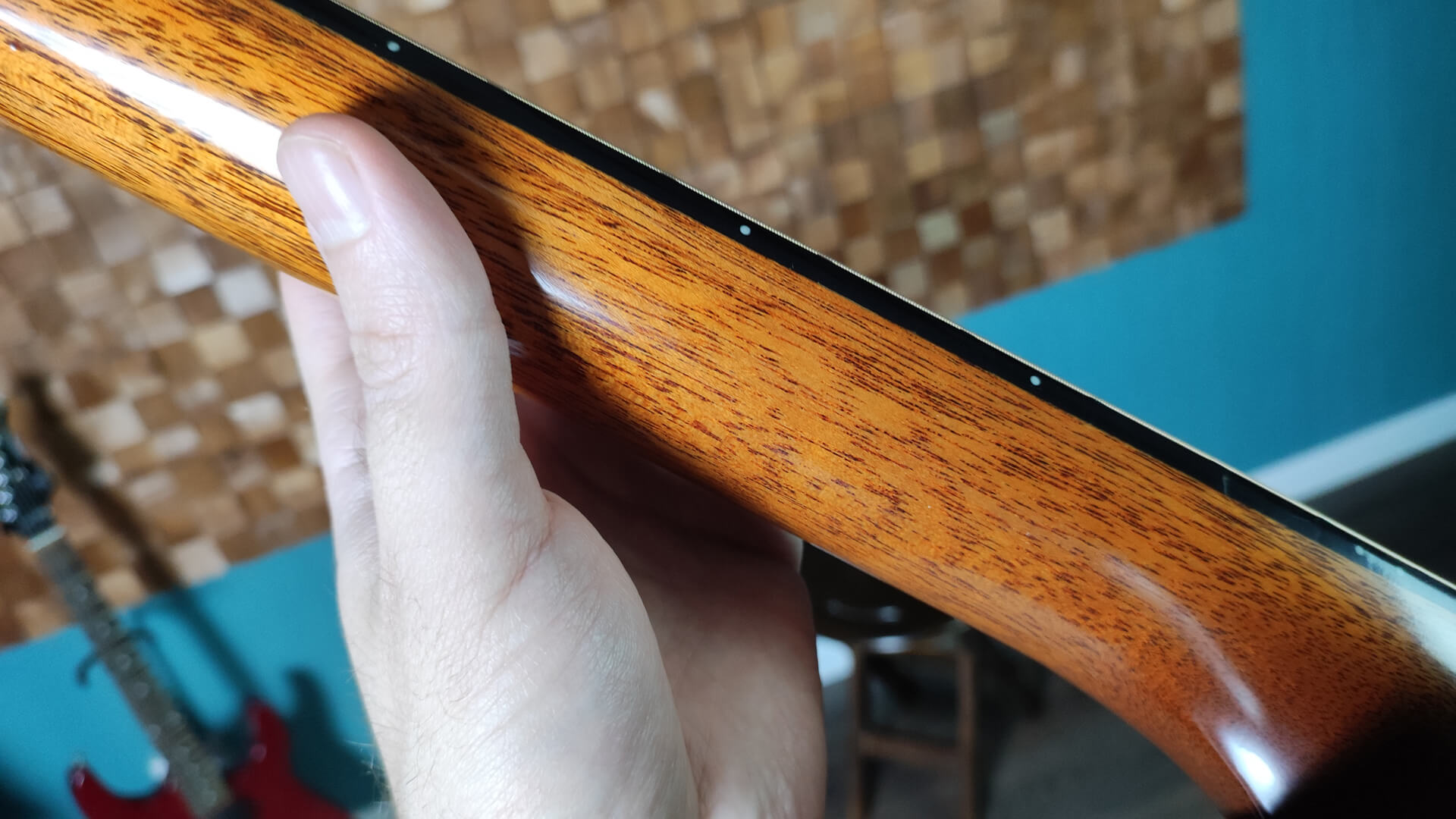


If the elbow goes back, move the guitar neck a little forward. And vice versa, if your elbow wants to move forward, pull the guitar fingerboard toward you. We adjust the guitar to the arm, and not vice versa. In this position, the left hand moves absolutely freely along the neck and feels comfortable in any position. We will talk in more detail about the left hand in a further topic.
The only disadvantage of holding the guitar on your left thigh is playing in the first positions, as you need to keep your hand pretty high, which is not as comfortable. If you hold your hand without the guitar in that position, it gets tired quite quickly.
Right hand placement on the guitar.
The right-hand rests on the guitar with the forearm slightly below the elbow over the bridge and at about a 45° angle to the strings (Figure 23).
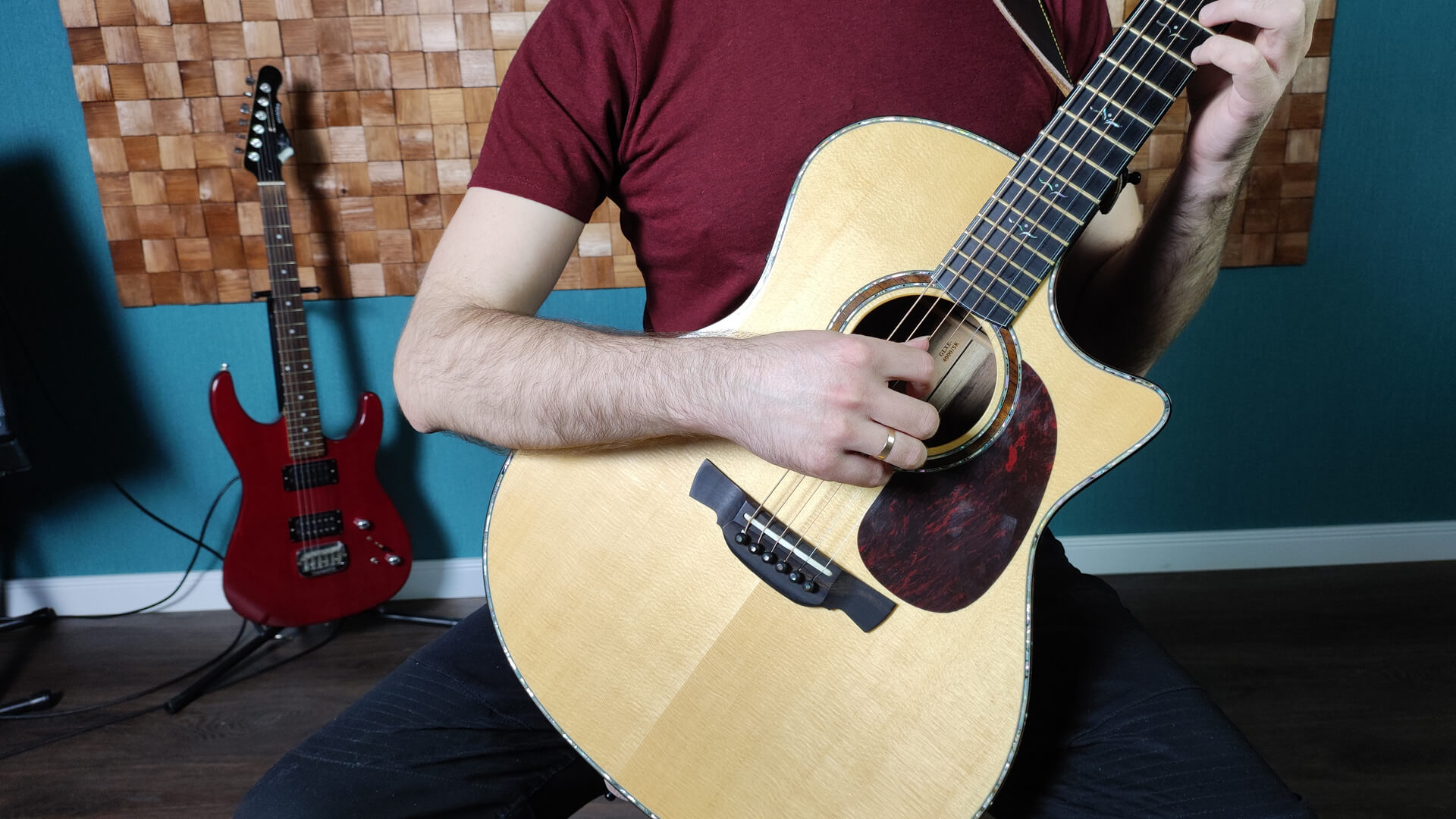
Put your finger p on the fourth string, i on the third, m on the second, a on the first, e (c) hanging freely in the air without bending or straightening. The finger i must be in the center of the sound hole. If you do not know the names of the fingers – read this article.
Touch the strings lightly with the very tip of your finger. Fingers should resemble a semicircle in shape (Figure 24). This is the optimal finger position, which gives a sound suitable for most tasks. Depending on the song, we can change this position, depending on the musical objectives. The closer your hand is to the bridge, the harder the sound will be. The closer your hand is to the fingerboard, the softer the sound will be. The hand should not bend left or right, up or down, while also being in line with the forearm.
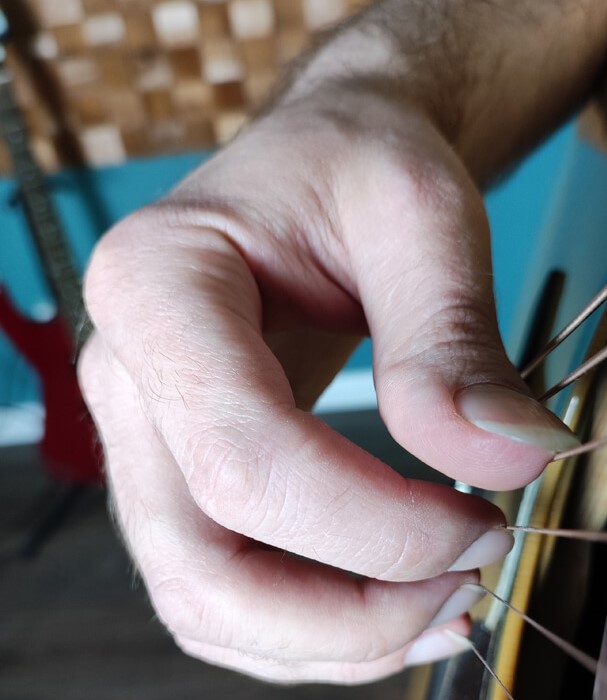
If you did everything right, in the end, you get four points of support: two legs, a chest, and the right hand lying on the guitar. In this position, the guitar is as stable and comfortable as possible, without restricting movement of the hands. And you feel completely relaxed, as if you were just sitting in a chair without a guitar.
Guitar positioning for the right thigh.
Take your guitar and place it on your right thigh with the special curve on the sides of the guitar. But not in the center of your thigh, but closer to your body (Figure 25).
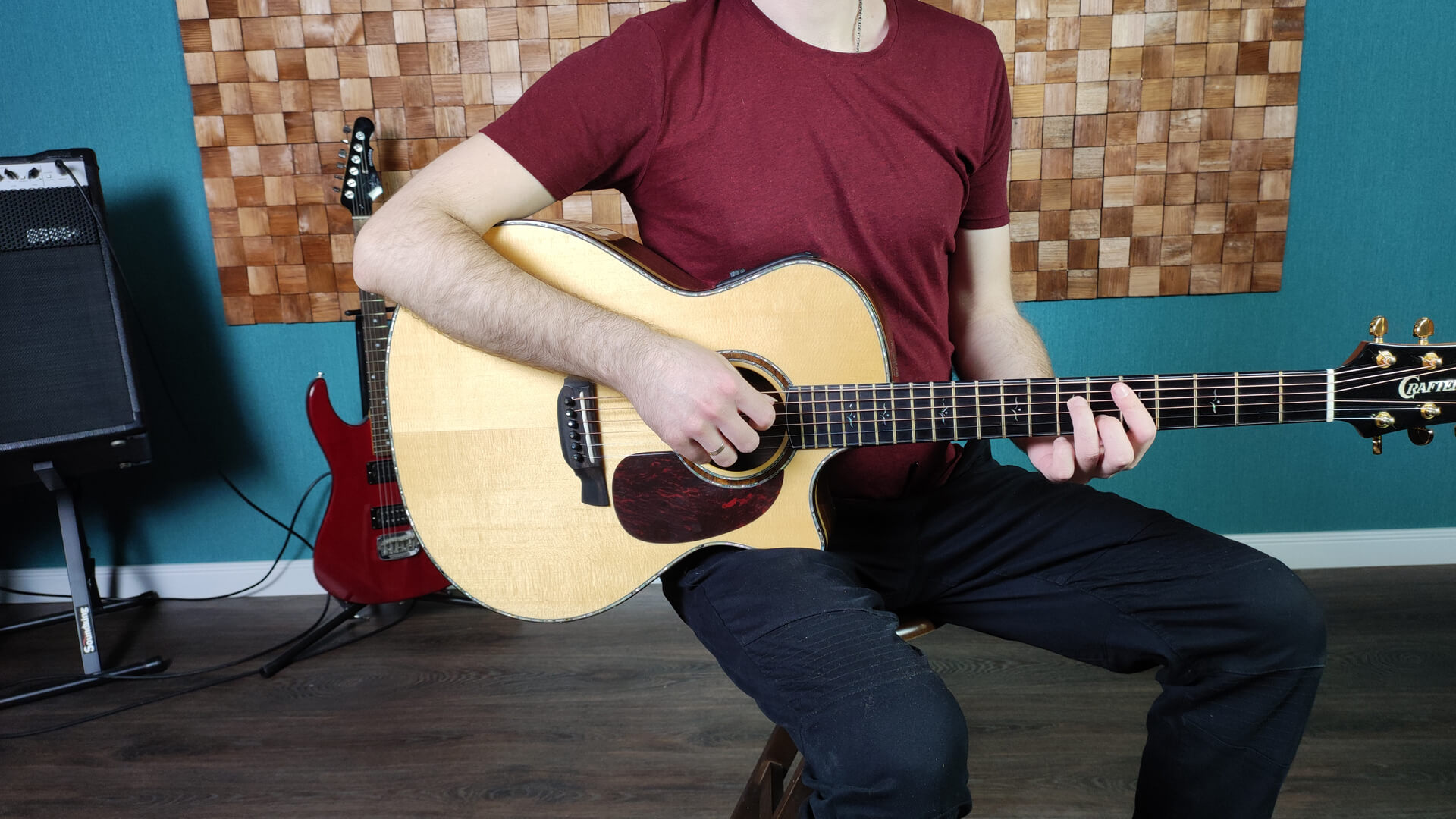
The right-hand hugs the guitar so that its edge falls on the inner part of the elbow joint. Thus, the right hand is at an angle of 30°. In this 30 degree positioning, the string will be almost vertical to your fingers. This results in your fingertips sliding down strings instead of lightly plucking. Potentially causing squeaky notes.
To compensate for the squeaky note sound, some people will do an unnatural bend with their wrist to correct their finger positioning (Figure 26). This unnatural bend in the wrist can lead players to experience pain within a short time.

To avoid these problems, instead of hugging the guitar, you can place your forearm, slightly below your elbow over the guitar’s bridge (Figure 27). Then the angle of the hand in relation to the strings will increase to 45°, but the stability of the guitar will decrease.
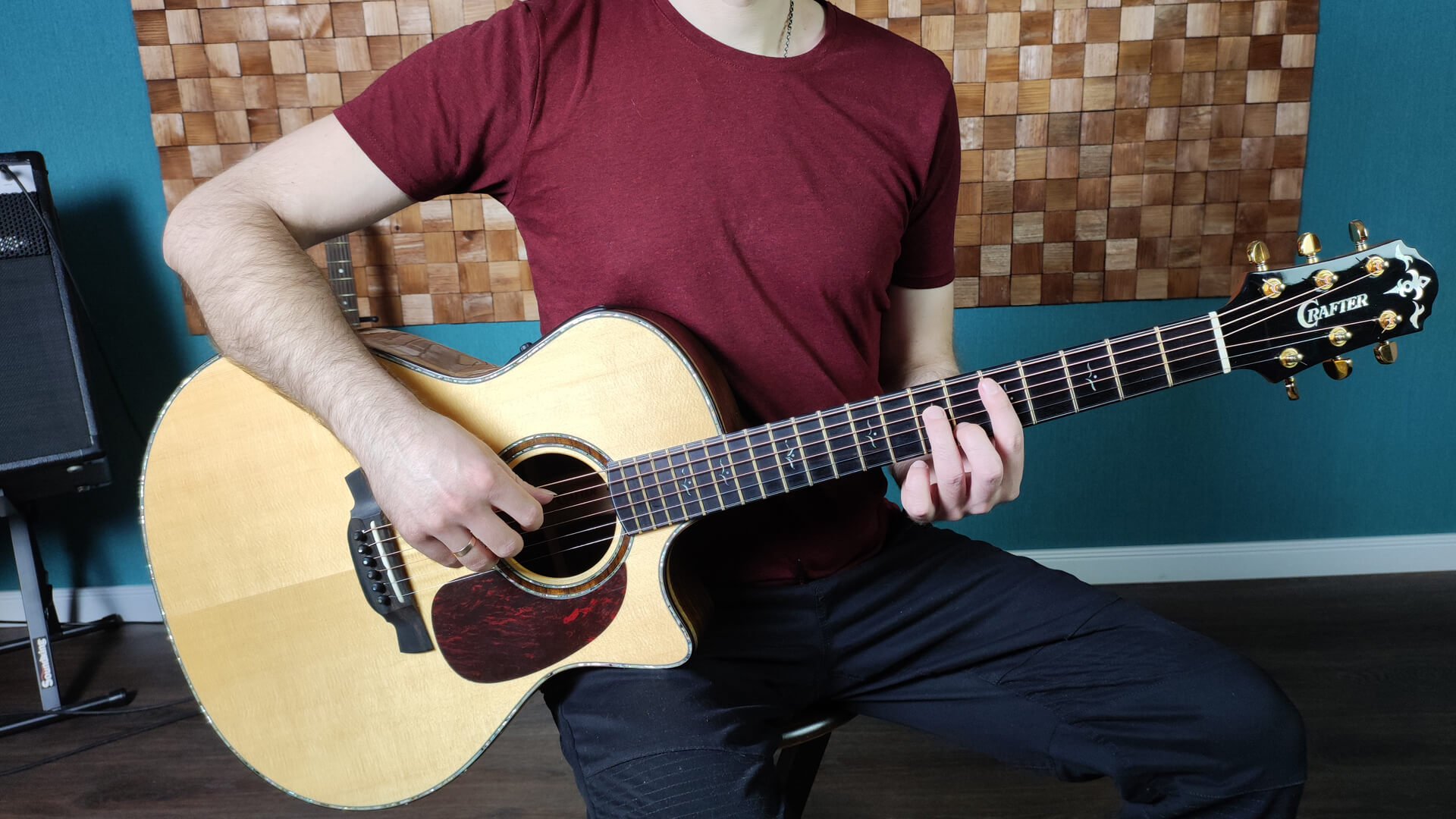
Place your fingers on the strings in the same way as in the previous chapter (Figure 24).
In this position, you may notice several features:
- Instead of four points of support (as it was when we held the guitar on the left thigh) we get only three: the right thigh, chest, and the right hand lying on the guitar. Consequently, we lose the immobility and stability of the instrument.
- Basically, you can only see the sixth string, the others are not visible. To somehow fix the situation, you can move the guitar slightly forward on your thigh and tilt it toward you. But in this position, the guitar feels even more unstable.
- The neck will be quite low and parallel to the floor. This causes you to have to bend down to make it comfortable for your left hand to play, especially when playing difficult chords and barre. To make it more comfortable for you to play, the angle of the guitar neck in relation to the floor should be at least 10-20 °. This angle can be achieved with these methods:
- using a guitar footrest, a guitar leg pad, or special support that is attached to the side of the guitar (Figure 29, 30).
- cross your legs (ankle on knee, or ankle over ankle) which automatically raises the neck higher and allows your left hand to play more comfortably (Figure 28). The disadvantage of this position is that your legs go numb quickly.
- The right hand is locked to one position as it hugs the guitar, and it cannot easily move to the bridge or to the neck. That doesn’t mean you can’t move it (for example, on the fingerboard when playing artificial harmonics). It just won’t be as comfortable as when you hold the guitar on your left thigh, because of the fewer support points and the movement of your right hand. The guitar will be very unstable.
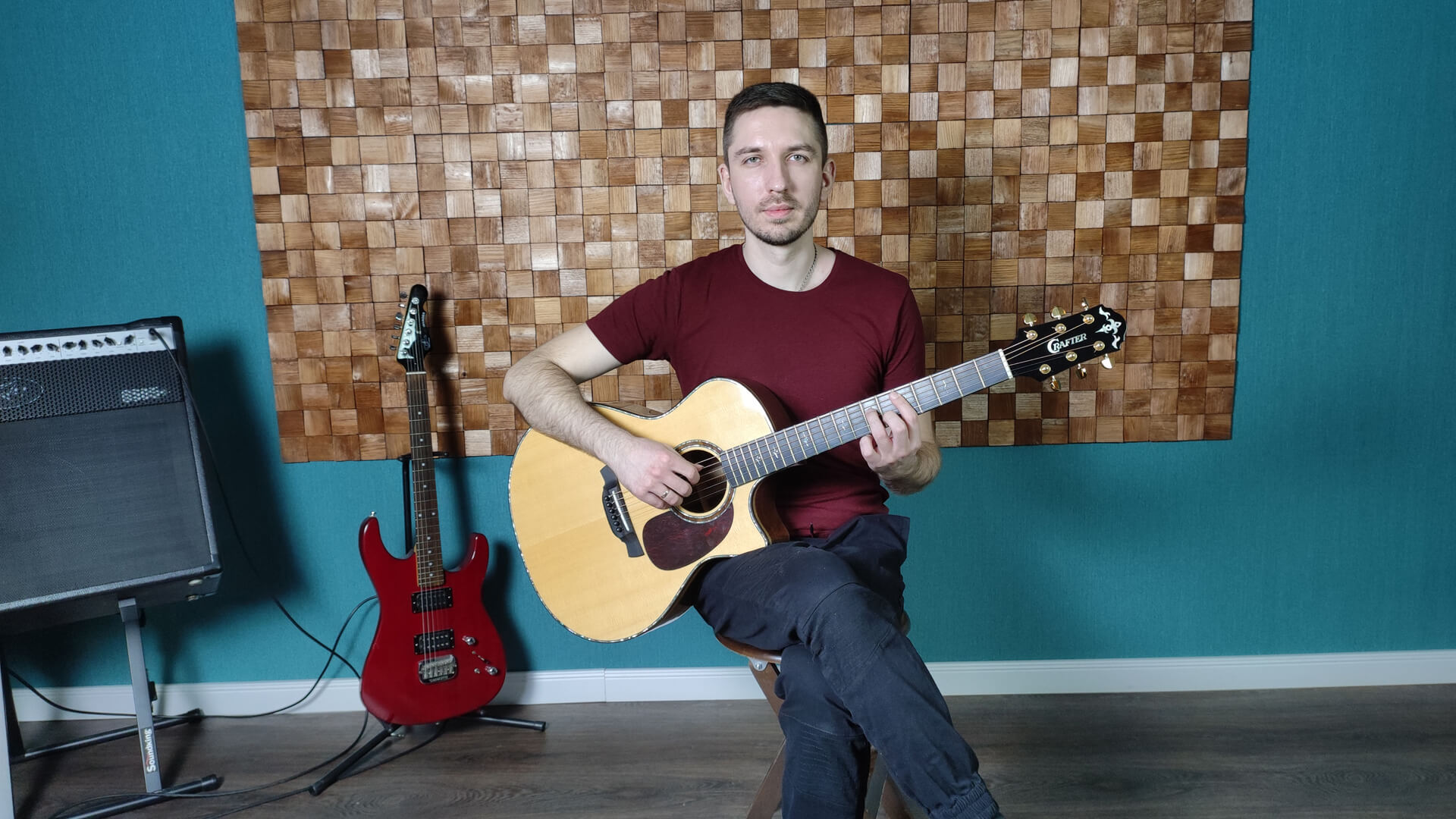
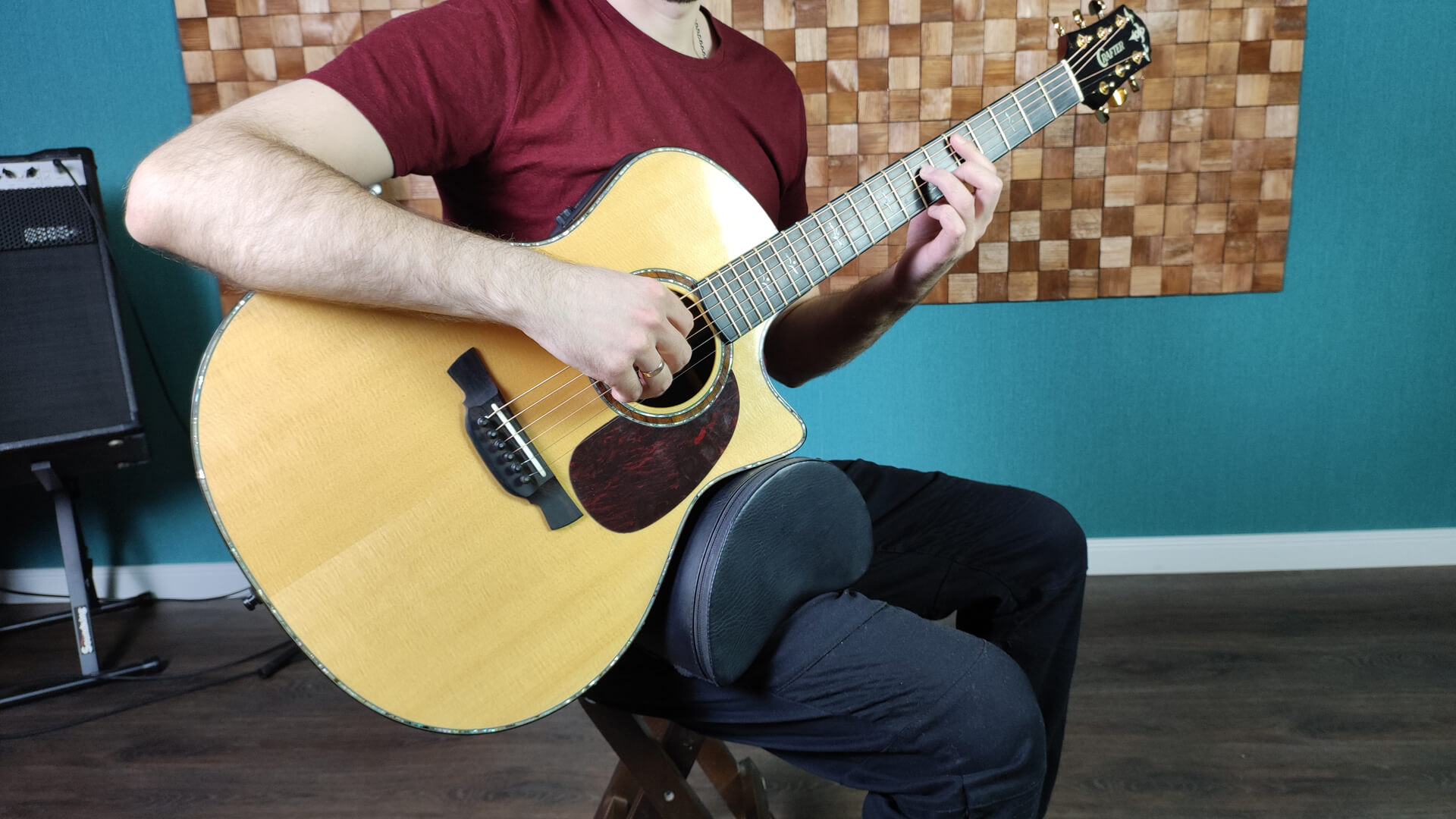
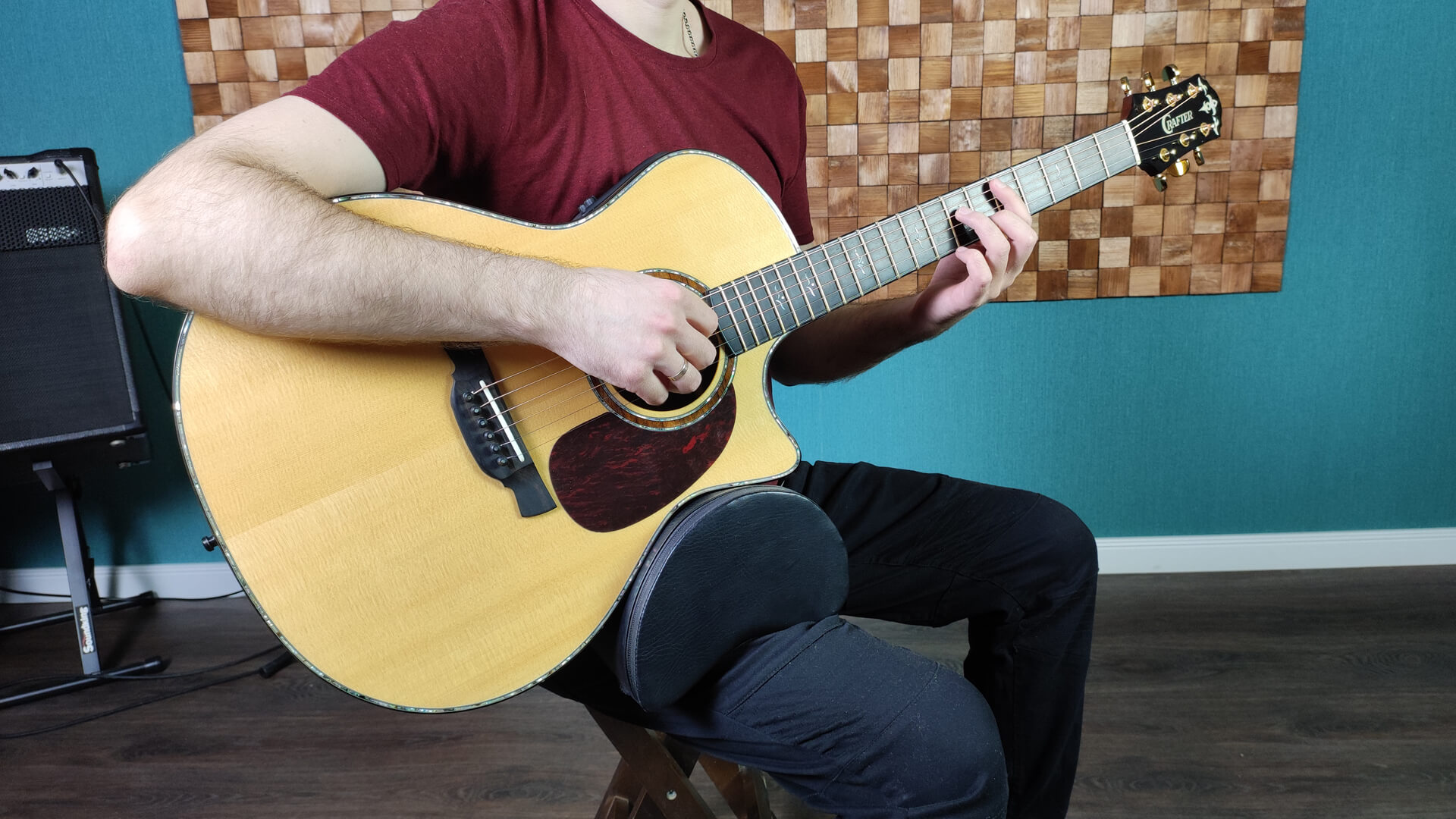
As we can see, holding the guitar on the right thigh is much more uncomfortable than holding the guitar on the left thigh. This begs the logical question, why do so many guitarists still play with their guitar on their right thigh? There are several reasons:
- In the beginning, it’s very convenient for us to take a guitar underarm and put it on the right thigh (Figure 31). Objectively, it’s much more convenient than putting the guitar on your left thigh (Figure 32). But, you don’t just have to hold it, you have to play on it as well.
- Subjectively, holding the guitar on your right thigh looks cooler, for some people.
- No one told them that a different way is possible.
- If you record a video of your guitar playing close-up, you will find that it fits the camera better when you hold it on your right thigh.
- If you play the guitar for many years, you’ll get used to holding the guitar on your right thigh. But don’t confuse habit with comfort.
- Most importantly accurate knowledge about how to hold a guitar on your left thigh properly, isn’t readily available. Especially detailed instructions so you know you have everything in place correctly for the best comfort.
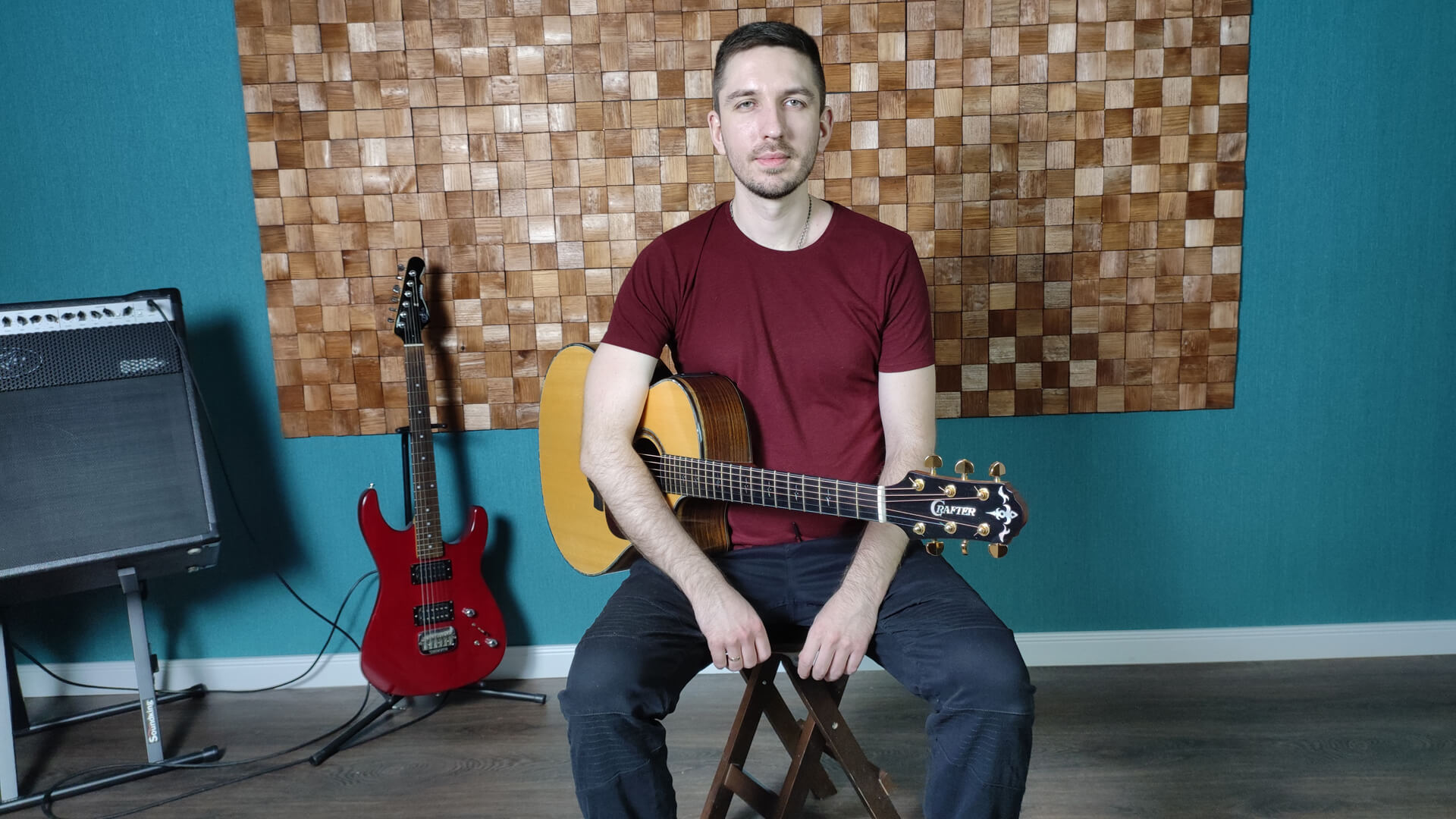
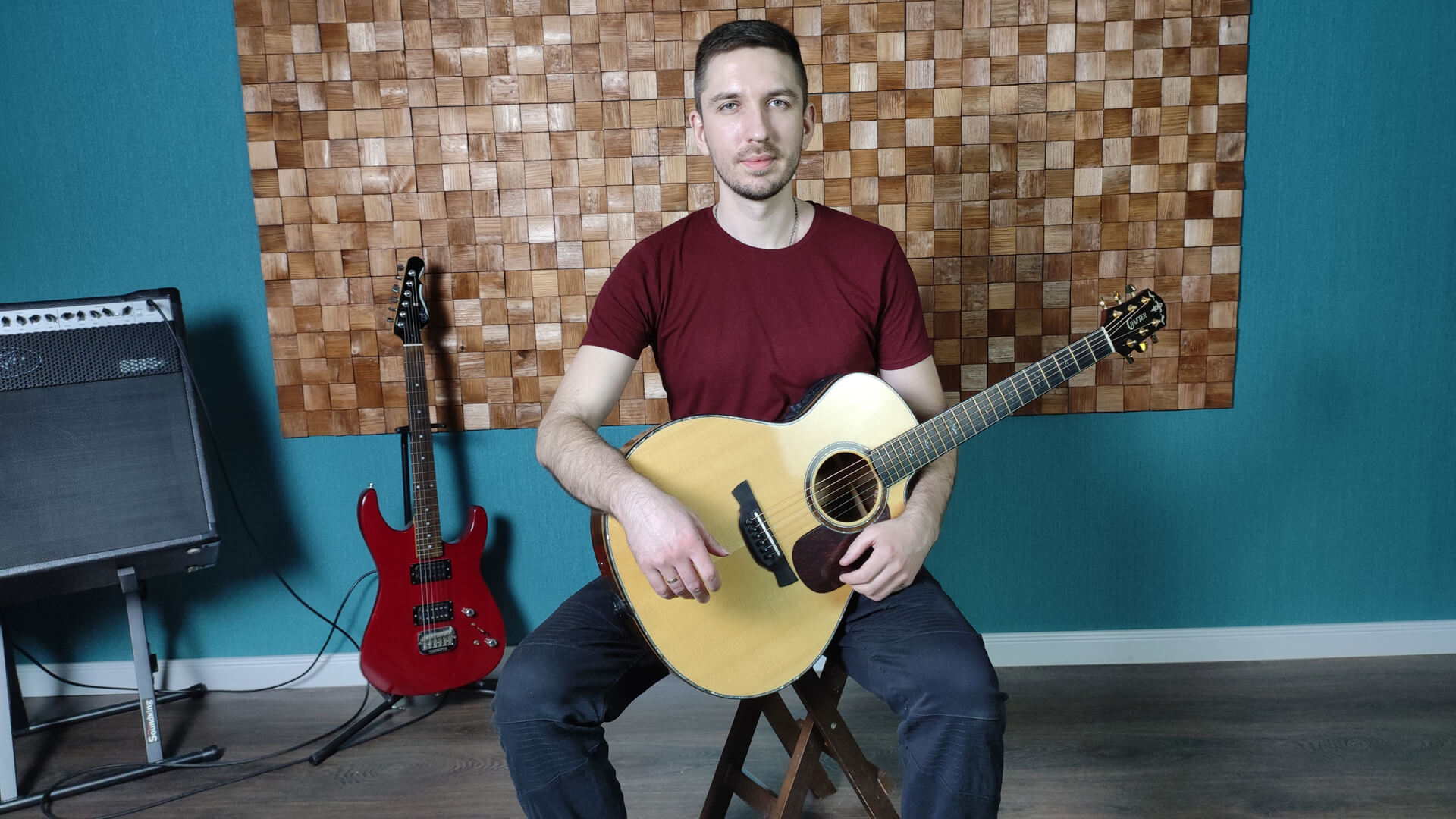
Playing with the guitar strap.
Using a strap, the guitar can hang over either the left or the right thigh, replacing any guitar supports. You can play either sitting (Figure 33) or standing (Figure 34). The right and left hands are placed in exactly the same positions as if you were playing holding the guitar on the left thigh or on the right. Although, if you are used to holding the guitar on your right thigh hugging the guitar, then while standing up you will have to move the guitar from the fulcrum of your right elbow to your forearm.

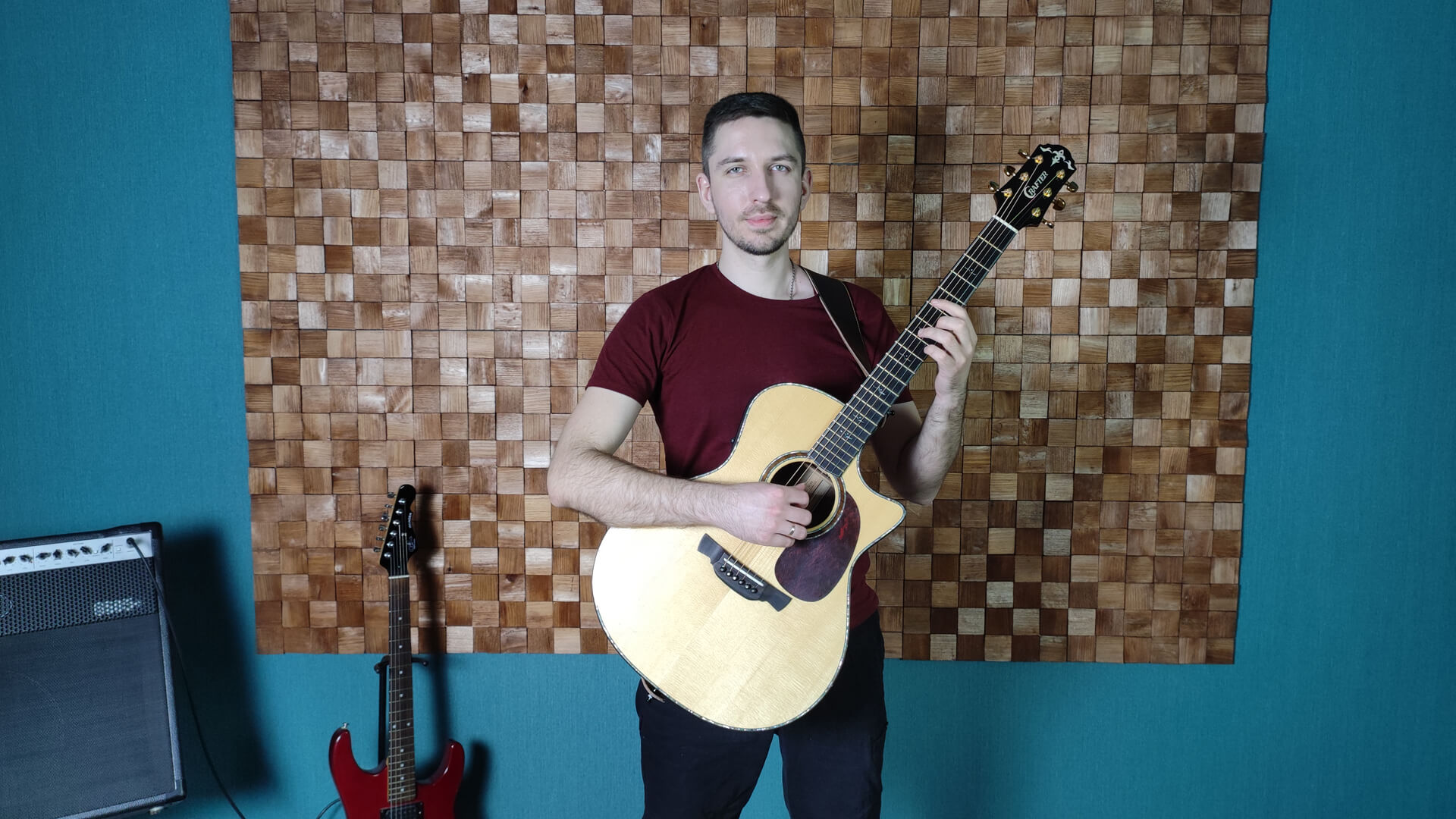
With the strap length adjustment, you should find a position so that the guitar fully maintains its position, as if standing on your thigh, guitar leg pad or support. Because the guitar is hanging in the air and not resting on your left thigh, its stability is decreased.
Playing sitting down usually does not pose a problem. However, if you play standing up, the guitar will lean against your body. As a result, you lose the ability to see the strings and it will not be comfortable to play in general. The triangle between the body and the guitar that we talked about at the beginning is lost (Figure 35).

Often, guitarists who are trying to solve this issue will use a special bolster to solve this issue, such as John Gomm.
Since the guitar still has a certain weight, your shoulder may ache during long sessions or concerts. To minimize this effect, use a strap that has a wide width to evenly distribute the weight on top of your shoulder.
Pay attention to where the strap mount should be located on the heel of the guitar’s neck (Figure 36). A rather strange situation has happened. All acoustic guitars have a guitar strap mount on the bottom of the body. But, very often manufacturers don’t put a strap mount on the heel of the neck at all. This is very strange. Where should I mount the strap then? If your guitar doesn’t have such a mount, contact a guitar craftsman to have one installed.
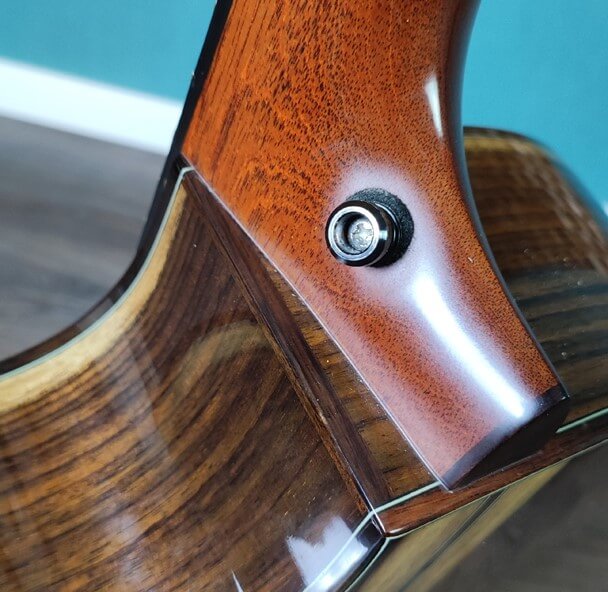
Сonclusions
Judging from all of the above, I would recommend playing with your guitar on your left thigh with guitar leg pad or special guitar support or with a strap. This way you will avoid many problems and discomfort, arm and back pain when playing the guitar.



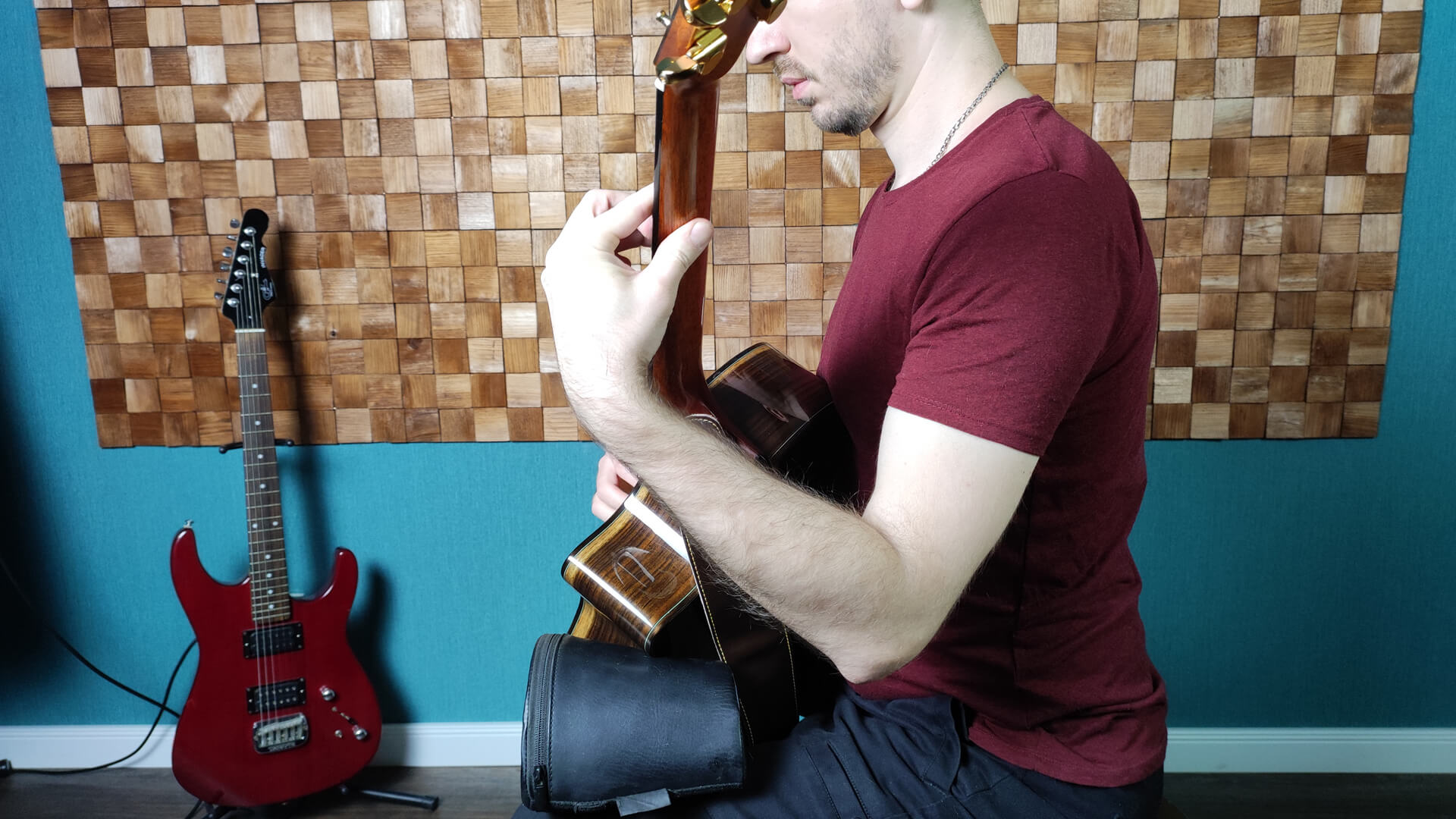
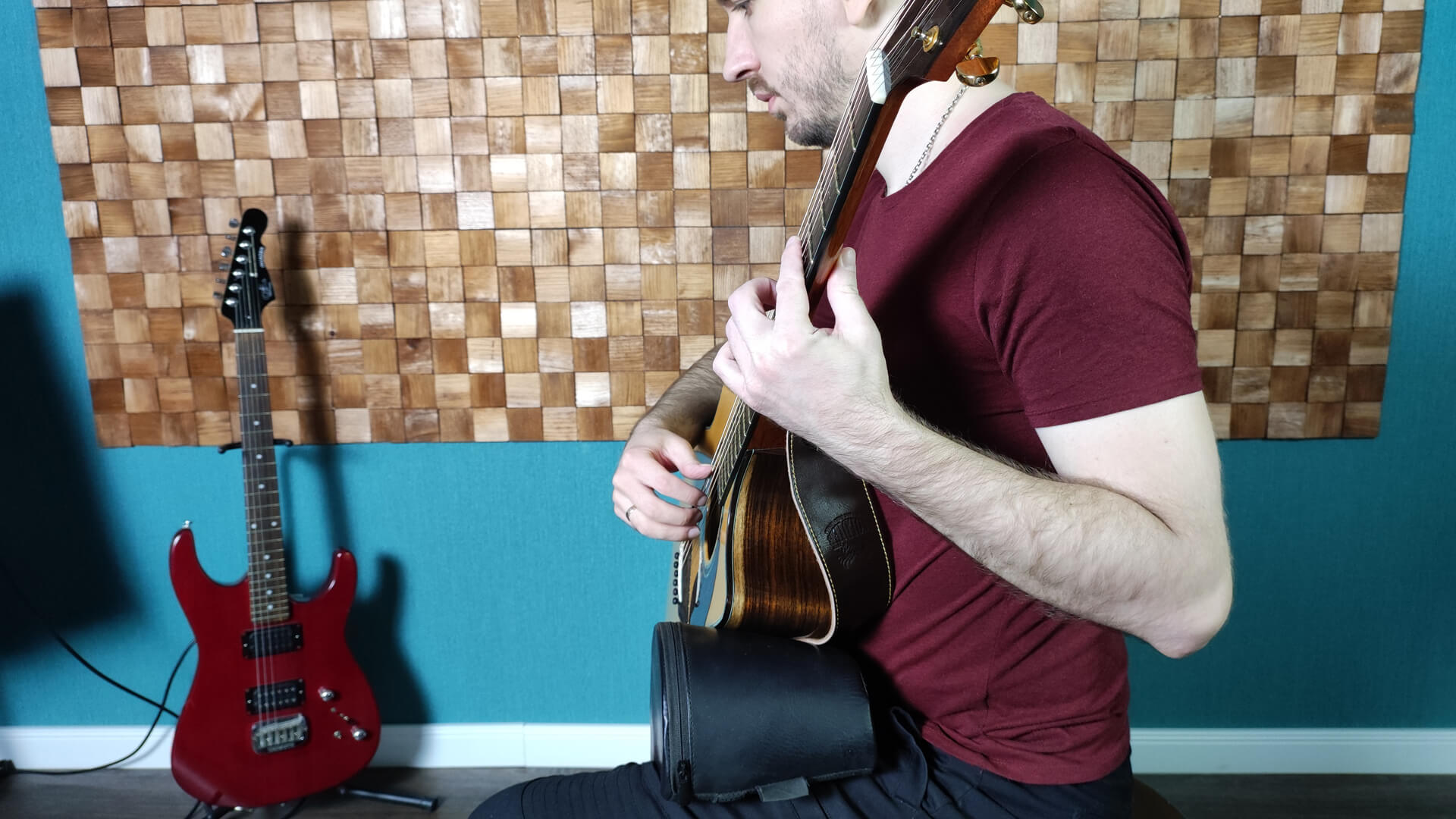



You must be logged in to post a comment.